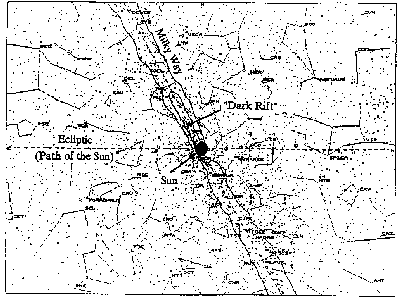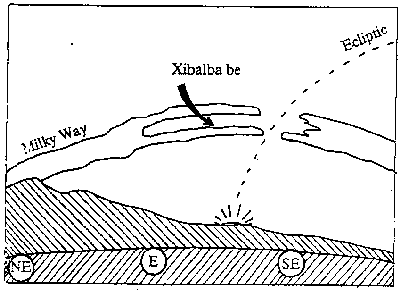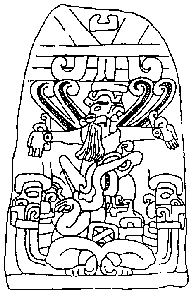Mayan Cosmogenesis: Cosmic Mother Gives
Birth
by John Major
Jenkins
April 1995
Introduction
In recent years, several books have been published in England with,
especially in the U.K., a good deal of success. Robert Bauval and
Adrian Gilbert wrote The Orion Mystery (1992) and, in addition to
becoming brief media celebs, turned Egyptology on its head. Graham
Hancock produced
Fingerprints of the Gods (1995) and injected some
old ideas about
Atlantis rising with some intriguing new
perspectives. Most recently, Adrian Gilbert with Maurice Cotterell
published the disappointing Mayan Prophecies which presumed to tell
us why cataclysm will occur in A.D. 2012. Hancock and Bauval are
presently working together on another book about Egypt. Gilbert, Bauval, Cotterell and
Hancock pursue the often unrewarding path of
independent research, striving to present compelling new ideas which
tenured academes are too thick-skulled to acknowledge. Like
Englandís other Fab Four, these independent researchers say we want
a revolution, and offer us one. They have all at some point
struggled to identify what is so astronomically special about the
opening of the new millennium. Theyíve discussed sunspots and pole
shifts, magnetic field reversals and the movements of Orion, but
their solutions are in disagreement and are generally unsatisfying.
They have all narrowly missed finding the "key."
As pin-pointed by the end-date of the
Mayan Calendar, the turn of
our millennium is attended by a rare celestial alignment between the
sun and our galaxy, one that has been slowly converging for
thousands of years. The winter solstice sun will align with the
Milky Way in A.D. 2012. Moutain Astrologer published my article on
this topic in their December 1994 issue. Since then, Iíve written a
110-page monograph detailing evidence for my thesis. Without mincing
words, I feel that this simple alignment is the answer which all
those writers sought. The irony, perhaps, is that the impending
solstice-galaxy alignment was first mentioned back in 1969 in
Giorgio de Santillana and Hertha von Dechendís groundbreaking book
Hamletís Mill. My own research starts where they left off. It has
taken 25 years to clarify how the Maya are involved in all this and
to understand how the alignment marks the beginning of a new precessional cycle
in humanityís spiritual and cultural work. The
alignment which I believe is so critical to understanding Mayan
creation mythology as well as our own impending shift also has the
benefit of being a straightforward fact of astronomy; itís not the
product of a labyrinth of convoluted speculations. What I offer is a
synthesis of two simple facts:
The ancient Maya apparently understood that the future alignment
would have apocalyptic effects, and designed their World Age
mythology to remind us of something essential. Myth, legend, or
ancient message, whatever it is, clearly, it means we must all
remember where we come from, where everything comes from: Mother.
What follows is a brief synopsis of the authorís research into the
Mayan Calendar and Mayan Creation Mythology. An exciting
breakthrough is described which is so basic, yet so startling, that
many Mayan scholars have thus far refused to acknowledge it.
John Major Jenkins is an independent student of Mayan Time. He is
the author of articles for Mountain Astrologer, Iron Feather
Journal, Zeitgeist, Scenezine, World Explorer Magazine, The
Borderlands Journal, and five books on Mayan cosmology including
Tzolkin: Visionary Perspectives and Calendar Studies (1994) and the
forthcoming The Center of Mayan Time (1995)
We are living today in the Mayan end times.
The Great Cycle of the
Mayan Long Count calendar ends on the winter solstice of 2012 A.D.,
less than 18 years from now. Following Mayan concepts of cyclic time
and World Age transitions, this is as much about beginnings as
endings. In fact, it was considered by the ancient Maya to signify
the Creation of a new World Age.
End of the Mayan Great Cycle: December 21st, 2012 A.D.
Scholars today are recognizing that Mayan mythology is intimately
related to the celestial movements of stars, the Milky Way and
certain constellations. The sources of Mayan mythology are found in
the sky, and the timetable of Creation Day is pinpointed by the end
date of the Mayan Great Cycle. My research into the nature of this
date reveals that a rare celestial alignment culminates on it.
Generally speaking, what occurs is an alignment between the galactic
and solar planes. Specifically, the winter solstice sun will
conjunct the Milky Way, which is the edge of our spinning galaxy as
viewed from earth. Furthermore, the place where the sun meets the
Milky Way is where the "dark-rift" in the Milky Way is - a black
ridge along the Milky Way caused by interstellar dust clouds (See
Diagram 1 below).

Diagram 1:
The sky on December 21st, 2012 A.D.
showing a rare astronomical alignment -
the winter solstice sun is right in the
"dark rift" in the Milky Way.
This is a feature of the Milky Way anyone can see on a
clear midsummerís night, away from the light pollution of industrial
society. At dawn on the winter solstice of A.D. 2012, the sun will
be right in this dark-rift, and the orientation is such that the
Milky Way rims the horizon at all points around. Thus, the Milky Way
"sits" on the earth, touching it at all points around, opening up
the cosmic sky portal. The galactic and solar planes are thus
aligned. "Sky portal" is just a term to describe the "opened sky"
scenario apparent when the Milky Way rims the horizon. This is not
to be confused with the "dark-rift" itself.
In Mayan myth, the winter solstice sun corresponds to the deity
One Hunahpu, also known as First Father. The Mayan Sacred Book, the
Popol Vuh, is all about setting the stage so that the
Hero Twinsí
father (One Hunahpu) can be reborn, thus beginning a new World Age.
The dark rift has many mythic identities: it is the Black Road; it
is the xibalba be (the Road to the Underworld); it is a crevice in
the branches of the cosmic tree (the Milky Way); it is the mouth of
the Cosmic Monster (often portrayed as a frog, jaguar or snake with
tree-like features); it is the birth canal of the Cosmic Mother.
Overall, the dark-rift is best understood as the birth canal of the
Cosmic Mother, who we may call First Mother, to complement
First
Father. In this way we can trace how these various metaphors are
found in Mayan Creation Mythology. And the date of this alignment
is, again, the end date of the 13-baktun Great Cycle - a cycle of
approximately 5125 years. This all suggests that the ancient
Maya
were aware of the impending alignment and considered it to be of
such importance to be a major transition point, the Creation of a
new World Age. In mythological terms, this event is about the union
of First Father with First Mother or, more accurately, the birth of
First Father (the winter solstice sun - the new World Age ruler)
from First Mother (the dark-rift in the Milky Way). The headline
appropriate for the upcoming event is:
"Cosmic Mother Gives Birth to The First God."
World Ages: Precession of the Stellar Frame
The slow process by which the winter solstice sun comes to conjoin
the dark-rift in the Milky Way is a function of a phenomenon known
as the precession of the equinoxes. This involves the slow wobbling
of the earthís axis, which causes the stellar frame to slowly shift.
To observers on earth, it causes the position of the winter solstice
sun to slowly move in relation to celestial background features such
as the Milky Way. A full cycle is completed in roughly
26,000 years.
Approximately 2100 years ago, when both the Long Count calendar and
the Popol Vuh were devised by the early Maya, the dark-rift in the
Milky Way could be observed some 30 degrees above the dawning winter
solstice sun (See Diagram 2 below).

Diagram 2:
Winter solstice sunrise from the early Mayan site of Izapa,
50 B.C. Notice the dark rift in the Milky Way, the
celestial birth canal of Cosmic Mother,
some 30 degrees above the rising sun.
When these early skywatchers
discovered precession, they realized that every winter solstice the
cosmic birth canal was moving closer and closer to the dawning sun.
The winter solstice sun was called the First Sun, the First Lord or
First Father, because it is the first day of the year, the beginning
of the sunís annual rebirth into increasing daylight. They
calibrated the process, and fixed their Creation Mythology to the
future alignment as described.
Monuments from the early
Mayan site of Izapa clearly portray, by way
of mythological iconography, the anticipated astronomical alignment
of the Long Count end date (See Diagram 3 below). In this way, the
Long
Count calendar and Popol Vuh Creation Mythology (portrayed on
Izapan
monuments and elsewhere) work together to describe the future
astronomical alignment. Furthermore, scholars believe that Izapa, an
unassuming early-Maya cultural center near the Guatemalan border in
Mexico, is where both the Long Count calendar and the Popol Vuh myth
originate.

Diagram 3:
Stela 11 from Izapa shows Cosmic Father in the "mouth" of
Cosmic Mother, the "dark rift" or "birth canal" in the
Milky Way. This is an image of the celestial alignment
which culminates in A.D. 2012.
Ancient Cosmology Points To Our Immediate Future
Based upon these simple facts, ancient skywatchers in Mesoamerica
were apparently aware of a subtle celestial process, the precession
of the equinoxes. Knowledge of that process, and the fact that a
major alignment in that process culminates at the end of their Great
Cycle, strongly suggest a cosmological understanding which modern
scholars have yet to explore. While today the conjunction is hidden
behind the rays of the solstice sun, to early skywatchers the future
convergence would have been the focus of intense calendar
calculations and eschatological myth-making. As it says in the
Popol
Vuh:
"by sheer genius, by sheer accuity, they got it done."
People
interested today in the scope of ancient Mesoamerican knowledge
inescapably must incorporate these recent findings into their
thoughts. In doing so, we can better appreciate the profound scale
of the cosmological understanding possessed by ancient New World
cultures, to which millions of present-day Indians in Middle America
are heir.
The Fever: Millennial or Mayan?
Understanding this aspect of Mayan cosmogenesis may also help us
understand our own impending millennial milestone. What is going on
in the world today? Is this alignment having some kind of influence?
The precession of the equinoxes is, after all, primarily an
earth
rhythm. Whether we call it Mayan or millennial, we are living today
in the shadows of a rare celestial juncture which parallels the
increasing interest in "New World Orders", "post-historic" thinking,
and a major shift in world economic structure and what it means to
be human. The Mayan myth seems to remind us that all life springs
from the Great Mother. The transformation of cosmic recreation is
already occurring. Perhaps we should look closely at this celestial
alignment, imagine its meanings, and determine what this
transformational shift means for future humanity. For the ancient
Maya, on the far-future Creation Day which for us arrives soon,
First Mother and First Father join forces to engender a new World
Age.
Go Back